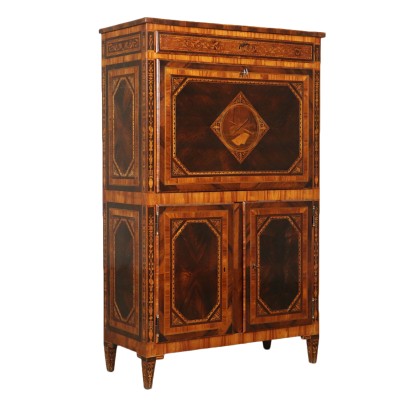Neoclassical Secretaire with Inlays Milan Italy Last Quarter of 1700s
Features
Age: 18th Century / 1701 - 1800
Origin: Milano, Lombardia, Italy
Main essence: Maple , Brazilian Rosewood , Tulipwood , Various Wood Essences , Rosewood
Material: Walnut Slab
Description
Impressive Neoclassical secretaire attributable to a famous cabinet-maker's workshop in Milan. Two doors on the front side, a drawer under the top and drop-leaf door with inlaid music panoply in the middle. Quadripartite rosewood reserves on front side and sides with bois de rose and maple threads. Uprights with candlesticks and pyramidal feet. Inside, six drawers and open compartments. Pull-out briefcase hiding a secret compartment. Top with decorated leather and gilding. Richly inlaid. Published on Morazzoni. Manufactured in Milan, Italy, last quarter of the 18th century.
Product Condition:
Good condition. Wear consistent with age and use.
Dimensions (cm):
Height: 149
Width: 92
Depth: 41
Additional Information
Age: 18th Century / 1701 - 1800
18th Century / 1701 - 1800 Main essence:
Maple
Hard, light wood used for inlays. It grows mainly in Austria, but it is widespread throughout the northern hemisphere, from Japan to North America, passing through China and Europe. It is one of the lightest woods ever, tending to white, it is similar to lime or birch wood. The briar is used in the production of ancient secretaires .
Brazilian Rosewood
It is a hard, light blond wood, but with strong red and pinkish veins, which is obtained from tropical trees similar to rosewood. Its veins are reminiscent of striped tulips, which is why it is called tulipwood in English-speaking areas. It is used for inlays, often combined with bois de violette. In the 1700s and 1800s it was highly appreciated and used in France and England for precious veneers. It gives off scent for decades if not centuries after curing.
Tulipwood
Obtained from some types of acacia, it is a hard essence, with purplish-colored veins, used in the inlays, in which, alongside the bois de rose, it generates beautiful contrasts. Also useful for making bronze accessories stand out.
Various Wood Essences
Rosewood
Under the term Rosewood various exotic, hard and heavy woods have been united, characterized by a color that varies from pink to violet. Their origin is usually from Latin America, India and Africa and are still considered very valuable woods. Until the end of the eighteenth century, this name also referred to the bois de violette . In general, rosewood woods began to be imported into Europe starting in 1750 and were first used for veneers and inlays in England, flanked, by contrast, with lighter woods. Later, entire valuable furniture was manufactured both in England, mainly in the Regency style, and in France, starting from the Neoclassical period.
Material: Walnut Slab


































